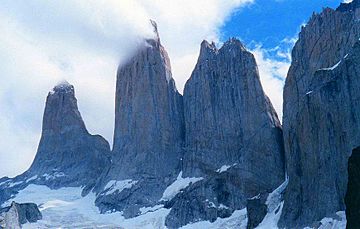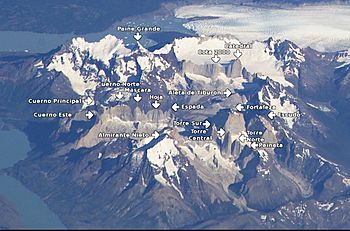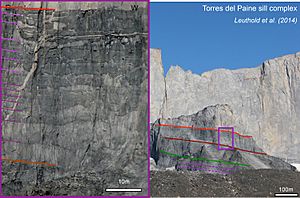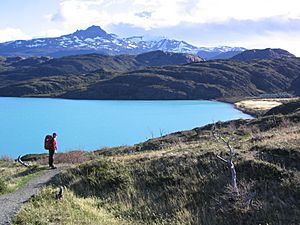Cordillera Paine facts for kids
Quick facts for kids Cordillera Paine |
|
|---|---|

Torres del Paine, Chile
|
|
| Highest point | |
| Peak | Cerro Paine Grande |
| Elevation | 2,884 m (9,462 ft) |
| Geography | |
| Country | Chile |
| State/Province | Magallanes y Antártica Chilena |
| Range coordinates | 51°S 73°W / 51°S 73°W |
| Parent range | Patagonian Andes |
| Geology | |
| Age of rock | 12 Myr |
| Type of rock | Granite |
The Cordillera Paine is a stunning group of mountains in Torres del Paine National Park in Chilean Patagonia. These mountains are located about 280 kilometers (174 miles) north of Punta Arenas. They are also about 1,960 kilometers (1,218 miles) south of Santiago, the capital city of Chile.
The Cordillera Paine belongs to the Commune of Torres del Paine. This area is part of the Última Esperanza Province in the Magallanes and Antártica Chilena Region. The word Paine means "blue" in the native Tehuelche (Aonikenk) language. It is pronounced PIE-nay. The heights of these mountains are approximate. This is because no exact surveys have been published.
Contents
Amazing Peaks
The tallest mountain in this range is called Cerro Paine Grande. For a long time, people thought it was much taller. Its height was believed to be around 3,050 or 3,251 meters (10,000 or 10,666 feet). However, in 2011, climbers measured it using GPS. They found its true height is about 2,884 meters (9,462 feet).
The Famous Towers of Paine
The three famous Towers of Paine, known as Torres del Paine in Spanish, are the main attraction of the park.
- The South Tower of Paine is thought to be the tallest of the three. It is about 2,500 meters (8,200 feet) high. Armando Aste was the first person to climb it in 1963.
- The Central Tower is about 2,460 meters (8,070 feet) tall. Chris Bonington and Don Whillans first climbed it in 1963. In 2017, three climbers from Belgium made history. Nico Favresse, Siebe Vanhee, and Sean Villanueva O'Driscoll were the first to climb its 1,200-meter (3,900 feet) rock face without using ropes for support.
- The North Tower stands at about 2,260 meters (7,410 feet) high. Guido Monzino was the first to climb this tower in 1958.
Other important mountains in the area include the Cuerno Principal. It is about 2,100 meters (6,900 feet) tall. There is also Cerro Paine Chico, which is usually said to be about 2,650 meters (8,700 feet) high.
How the Mountains Formed
The Cordillera Paine mountains are mostly made of a yellowish rock called granite. Underneath this granite are other types of rocks. These rocks were formed when hot, melted rock pushed its way up into older rocks. Over millions of years, giant glaciers carved out the valleys and shaped these mountains.
The steep, light-colored parts of the mountains are made of tough granite. The darker parts and the lower hills are made of older sedimentary rocks. These sedimentary rocks were laid down in the Cretaceous period, which was a very long time ago.
Scientists have studied the rocks in Cerro Paine. They found that the granite formed about 12 to 13 million years ago. This means the melted rock pushed up and cooled into solid rock during that time.
Exploring the Park
The Torres del Paine National Park is a huge area. It covers about 2,400 square kilometers (927 square miles). In 1978, UNESCO named it a Biosphere Reserve. This means it is a special place where nature is protected.
About 250,000 people visit the park every year. There are many trails for hiking and some campsites. Chile's National Forest Corporation helps maintain these areas. There are also mountain huts that offer shelter and basic services for visitors.
See also
 In Spanish: Cordillera Paine para niños
In Spanish: Cordillera Paine para niños





